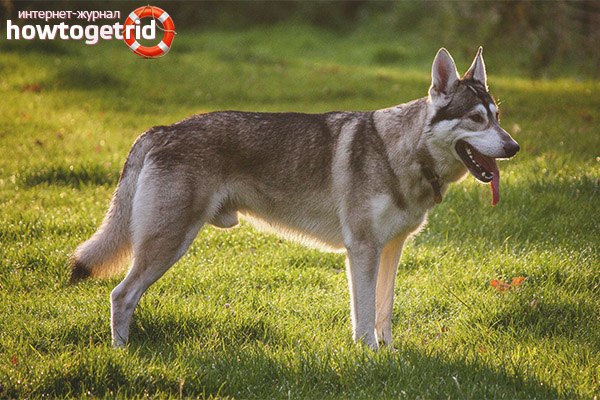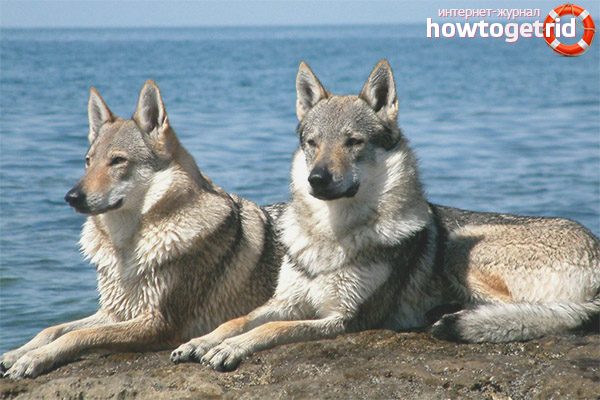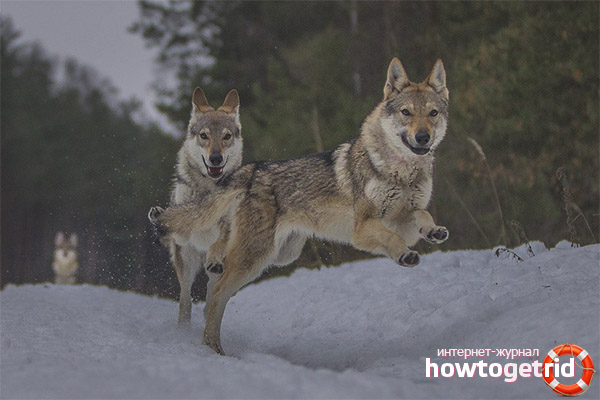The content of the article
- 1 Where and how did the breed originate?
- 2 The main features of the breed
- 3 Character and communication with a person
- 4 Training and work
- 5 How to contain Czechoslovakian wolfdogs?
- 6 How to care for a Czechoslovakian wolfdog?
- 7 How are Czechoslovakian wolfdogs sick?
- 8 Video: dog breed Czechoslovakian wolfdog
The Czechoslovakian wolfdog is a very unusual breed of dog that has the appearance of a wolf and the character of a real soldier who faithfully serves his master. By its qualities, the wolfdog is a very serious animal, which has a very bright appearance. It cannot be said that this breed is very widespread outside its native territory, however, Czechoslovakian wolfdogs have their loyal fans.
Where and how did the breed originate?
The first breeder who managed to get a litter from a wolf and a dog was Karel Hart. By his unusual experience, this enthusiast was able to prove that hybrid puppies can be born regardless of who exactly the mother and father were in the mixed pair.
In addition, Karel Hart was the first person who did not have the goal, after crossing, to obtain dog fighters suitable for duty or certain tasks. The sole purpose of this breeder was to bring out a bright, beautiful breed with a set of certain qualities.
First of all, the Carpathian wolf and the German shepherd were crossed. Further, the puppies obtained in this process were crossed with dogs. The resulting litters pleased the breeders, as the puppies showed excellent results in the training process, and were also very undemanding in terms of their maintenance and hardy. Thanks to these characteristics, the breed interested many dog handlers and aroused the interest of their professional community.
The popularity of vlchaks gradually increased, thanks to which by 1982 this breed became the national symbol of Czechoslovakia. In addition, despite the fact that initially the breeders did not have the goal of using such dogs for service, by this time the wolfdogs still attracted the attention of certain departments. So representatives of this breed began to work at the border, as well as in the protection of various objects. Already in 1999, the breed was officially recognized as the IFC standard.
The main features of the breed
Czechoslovakian wolfdogs have the following standards regarding appearance:
- The height of these animals at the withers of males starts at 65 cm, bitches slightly lower - from 60 cm.
- By weight, males are also slightly heavier than females; they have a mass of 25 kg, while females have a mass of 20 kg.
- The nose of this breed is traditionally black.
- Wolves' eyes are usually amber in color.
- Czechoslovakian wolfdogs have a dense straight coat, which in the cold season is additionally accompanied by a thick undercoat.
- The color of the wolves is mostly gray, can vary from light to dark shades, a light mask is present on the muzzle.
- The ears of the wolves are triangular in shape, small in size and high set.
- The breed is characterized by a straight or scissor bite.
- Also, with regard to teeth, such dogs have a full formula, that is, 42 teeth.
If we pay attention to the physique and color of the wolfdogs, we can conclude that dogs of this breed are very similar to wolves. In addition, this fact is also confirmed by some features of the behavior of wolfdogs. For example, their mobility is very light and energetic. Like wolves, wolfdogs have thick hair with a special structure that allows them not to freeze even in severe frosts.
If we compare the Czechoslovakian wolfdogs with other similar breeds, it can be noted that representatives of this species are smaller, however, this is easily compensated by increased endurance, which can not be said about other breeds. Breeder Karel Hart managed to bring out a breed that has a rather soft, unlike a wolf, character, thanks to which the wolfdogs are easy to train. However, representatives of this breed cannot be called cowards. A feature of such an unusual breed is the presence of many qualities that are completely not characteristic of dogs, but are inherent, rather, to wolves.
According to the standard, Czechoslovakian wolves belong to working dogs. Inside the breed, there are no divisions into subspecies.
Character and communication with a person
Today, Czechoslovakian wolfdogs start up primarily for the purpose of serving or for work. It is worth noting that these representatives have a very unusual character, which can not be called easy and simple. Therefore, these dogs are not suitable as pets for children, the elderly or those who lead an inactive lifestyle. This is due to the fact that not everyone can cope with such a breed.
Characteristic features and features of the behavior of wolves are:
- they do not imbue trust in strangers;
- quite difficult to get along with other animals;
- they like to howl and do it often enough;
- love freedom, and therefore can run away from home;
- they can be trained, however, they are not very simple in training;
- Wolves need to be constantly monitored and regularly engaged with them.
The most pronounced advantages of this breed are the following qualities:
- loyalty and devotion to its master;
- the best working qualities unique in its kind;
- increased energy and even tirelessness;
- bright, lively intelligence;
- lack of increased requirements for care and maintenance;
- sensitivity.
With other pets at home, the wolfdogs can have a very different relationship, however, if cats or dogs have been living in the house since childhood, friendship may well arise between the pets. In the process of raising such an animal, it is very important to immediately show your authority, as well as build the necessary relationships for wolfdogs with other family members. Otherwise, the pet will begin to dictate its own rules. During the puppy's growing up, unusual traits may appear in their behavior, however, if you approach the training correctly, you can avoid any problems.
Czechoslovakian wolfdogs are very fond of playing and react very quickly to any changes in the world around them. This breed of dog does not require constant and close attention, however, it is very important to immediately establish contact with the pet and periodically maintain it.
Training and work
The main difficulties in training Czechoslovakian wolfdogs, as a rule, arise due to their strong emotionality. It is for this reason that in the process of training the owner needs to be especially persistent, as well as patience. Otherwise, the puppy will simply create its own rules and behave as it wishes.
It is important to understand that there is no sense in trying to suppress such a complicated character of Czechoslovakian wolfdogs with the help of aggression, screams or tantrums. Dogs of this breed must be carefully guided in the right direction. Wolves are very sensitive, so they keenly feel the mood of their master. If a person panics, then the pet becomes restless. Various delicacies will be an excellent motivation for this breed, and it is important to have contact with the animal for effective training.
Thanks to unprecedented endurance, Czechoslovakian wolf dogs often harness themselves to sledding, which is a very popular entertainment in the Czech Republic.The speed of such dogs is slightly lower than that of other similar breeds, however, they are able to move without stopping for several hours.
To develop the ability of the wolves to hunt, they are often sent to a special training "course". Here dogs with great pleasure chasing hares and other animals.
Thanks to their wolf roots, wolves are able to track and sniff animals. In a flock, animals quickly determine their place and find a target for hunting. Representatives of this breed are characterized by excitement, which prompts them to search for prey.
Czechoslovakian wolfdogs have truly unique qualities:
- ability to protect yourself and your master;
- incredibly quick response;
- endurance;
- sharp scent.
In the homeland of Czechoslovakian wolfdogs, animals of this breed undergo rigorous selection and various tests. For example, such dogs are often tested for endurance using special running tests. Wolves can show other qualities in the learning process, as well as in further work or service.
How to contain Czechoslovakian wolfdogs?
Representatives of this breed feel great when living on the street. As a rule, they are not put on a chain. The best option is a spacious enclosure with a good area for a walk or just free movement of the dog in the area. It is worth noting that the wolfdogs love to run away, and therefore the fence on the site should be quite high. Dogs of this breed easily open doors and overcome various obstacles.
As a rule, a booth must be placed inside the enclosure. The size of the booth should allow the dog free movement inside, so that the animal can easily deploy there. Dense matter should be attached to the entrance of the booth, which will protect the animal inside from snow, blizzard and wind. It is worth noting that in most cases, representatives of this breed easily sleep right on the street. Small puppies can be moved to the enclosure in the warm season after they turn about 3-4 months old.
In the apartment, the wolfdogs, as a rule, find a secluded place in which they arrange a kind of couch. It is worth noting that Czechoslovakian wolfdogs are very fond of exploring the world around them and do this mainly with the help of teeth. Therefore, if you leave the apartment for a while and leave the puppy alone at home, it is better to put him in a special cage for a while.
Regardless of how you keep your wolfdog, you need to accustom him to walks from an early age. In no case should you keep the puppy in an apartment or other enclosed area for a long time. For walks, it is best to choose crowded places. This will help the pet get used to people and noise.
How to care for a Czechoslovakian wolfdog?
Czechoslovakian wolfdog can be fed with both natural and industrial feed. If you use natural nutrition, it is important to remember that the diet of the animal should include mostly meat. Also in the menu of the wolfdog must be present kefir, cottage cheese and a raw egg. It is very important to add offal to the diet, for example, boiled liver, heart and much more. Puppies should be given marine fish at an early age. In addition, this product will be very useful in the period of molting, as well as in pregnancy in females.
If you are choosing industrial food, then you should pay attention to the option for medium and active dogs. Food should not be too fat, since for wolfdogs such food is harmful. Also, many dog lovers note that representatives of this breed are very difficult to tolerate the transition from natural feed to industrial. If you are planning to transfer your pet to dry food, it must be introduced into the diet gradually, little by little.
Thanks to the thick coat, the wolfdogs do not need special clothes for walking.Moreover, the structure of their wool also protects against pollution. Thanks to this, Czechoslovakian wolfdogs practically do not need care.
During the season change, the animal should be monitored, since at this time very active molting begins in the wolves. You can help the animal by washing and drying with warm air. In addition, attention should also be paid to teeth. They must be periodically cleaned by a veterinarian.
How are Czechoslovakian wolfdogs sick?
In general, Czechoslovakian wolfdogs are famous for good health, however, there are still diseases that the dog’s body is not able to withstand:
- dwarfism;
- degenerative myelopathy;
- dysplasia of the hip as well as the elbow joint.
The life expectancy of representatives of this breed is 13-14 years. It should be noted that these diseases are quite common in dogs. For this reason, special laboratory tests are even carried out in the Czech Republic, which make it possible to identify the most common diseases in wolves.
Video: dog breed Czechoslovakian wolfdog












Submit